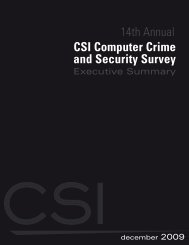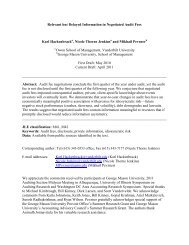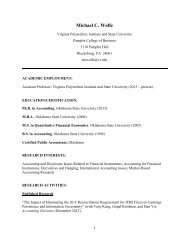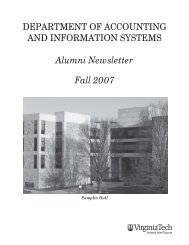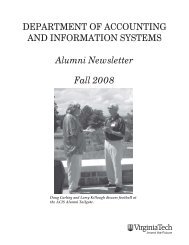2010/2011 Computer CrIme and SeCurIty Survey - Gatton College ...
2010/2011 Computer CrIme and SeCurIty Survey - Gatton College ...
2010/2011 Computer CrIme and SeCurIty Survey - Gatton College ...
Create successful ePaper yourself
Turn your PDF publications into a flip-book with our unique Google optimized e-Paper software.
<strong>2010</strong> / <strong>2011</strong> CSI <strong>Computer</strong> Crime <strong>and</strong> Security <strong>Survey</strong>by Robert Richardson, CSI Director<strong>2010</strong> / <strong>2011</strong>CSI <strong>Computer</strong> Crime <strong>and</strong> Security <strong>Survey</strong>With this document, the CSI <strong>Survey</strong> achieves its fifteen-year mark. Both the aims <strong>and</strong> format of thesurvey continue to evolve. As you’ll see in the findings that follow, many of the results reported byour respondents easily could have been predicted based on looking at results from the past severalyears. There has always been an almost surprising stability to answers about tools <strong>and</strong> methodologyin this survey <strong>and</strong> this year is not an exception.What is different, broadly speaking, is that there is considerably more context within which theseresults may be interpreted. There are a number of very good reports of various kinds now availableon the Web. All of them that we’re aware of, with the exception of this one, are either providedby vendors or are offered by analyst firms. That’s not to say that there’s anything wrong withthese sources. A tremendous amount of useful information is offered in these various reports. Butindependent research seems fundamental <strong>and</strong> we believe the survey provides this.Beginning last year, there were three important changes to this survey. The first was that a “Comprehensive”edition was offered, one of its key objectives being to attempt to take other reportfindings into account so that a proper context could be achieved. Additionally, the survey questionnaireadded questions that attempted to determine not only what security technologies respondentsused, but additionally how satisfied they are with those technologies. This year, we continueboth with a more comprehensive report document but also with the questions regarding satisfactionwith results.As was the case last year, respondents did not seem to feel that their challenges were attributableto a lack of investment in their security programs or dissatisfaction with security tools, but ratherthat, despite all their efforts, they still could not be certain about what was really going on in theirenvironments, nor whether all their efforts were truly effective.This lack of visibility into the severity of threats <strong>and</strong> the degree to which threats are effectivelymitigated is a perennial problem in security <strong>and</strong> it presents problems for anyone trying to makesense of the state of information security. If respondents are unsure about what is happening ontheir networks, one could well argue, how can they possibly provide meaningful information on asurvey questionnaire?We would argue that, for typical security incidents, enterprise security departments have relativelyreliable <strong>and</strong> accurate powers of observation. They generally know when one strain or another ofa virus is making its way through their end-user population’s computers. They know when moneygoes missing from key bank accounts. And even if their perceptions on some points aren’t necessarilyaltogether accurate, having a gauge of the perceptions of security practitioners can be useful.1




